Knots… a simple way to learn how to master complexity and stress
- gbucknell

- May 15
- 3 min read
Here are detailed, step-by-step instructions for tying each of the knots commonly used in climbing, along with links to visual guides and animations to assist your learning:
1. Figure-Eight on a Bight
Purpose: Creates a secure loop in the middle of a rope.
Instructions:
Double the rope to form a bight.
Make a loop by crossing the bight over the standing part.
Pass the bight under the standing part and then through the loop.
Tighten the knot.
Visual Guide: 101Knots – Figure 8 on a Bight
2. Figure-Eight Follow-Through
Purpose: Secures a rope to a harness or anchor point.
Instructions:
Tie a loose figure-eight knot, leaving a long tail.
Thread the tail through the harness or anchor.
Retrace the original figure-eight knot with the tail.
Ensure the knot is tight and dressed properly.
Visual Guide: The Knots Manual – Figure 8 Follow Through
3. Figure-Eight Bend
Purpose: Joins two ropes of similar diameter securely.
Instructions:
Tie a loose figure-eight knot in one rope.
Thread the second rope through the knot, following the path in reverse.
Pull both ends to tighten and dress the knot.
Visual Guide: Animated Knots – Figure 8 Bend
4. Bowline
Purpose: Creates a fixed loop at the end of a rope.
Instructions:
Make a small loop, leaving enough rope for the desired loop size.
Pass the working end up through the loop, around the standing part, and back down through the loop.
Tighten the knot.
Visual Guide: NetKnots – Bowline
5. Double Bowline
Purpose: Provides a more secure loop than a standard bowline.
Instructions:
Form a small loop, then wrap the working end around the standing part twice.
Pass the working end through the loop, around the standing part, and back through the loop.
Tighten the knot.
Visual Guide: NetKnots – Double Bowline
6. Bowline on a Bight
Purpose: Creates a secure loop in the middle of a rope.
Instructions:
Double the rope to form a bight.
Make a loop in the bight.
Pass the bight through the loop, then around the standing parts, and back through the loop.
Tighten the knot.
Visual Guide: Animated Knots – Bowline on a Bight
7. Clove Hitch
Purpose: Attaches a rope to a post or carabiner.
Instructions:
Wrap the rope around the post, forming a loop.
Cross over the standing part and wrap around the post again, forming a second loop.
Tuck the end under the second loop and tighten.
Visual Guide: NetKnots – Clove Hitch
8. Munter Hitch
Purpose: Used for belaying or rappelling with a carabiner.
Instructions:
Make a loop in the rope.
Twist the loop to form a second loop.
Clip both loops into a locking carabiner.
Ensure the load strand is on the spine side of the carabiner.
Visual Guide: NetKnots – Munter Hitch
9. Prusik Knot
Purpose: Allows a smaller rope to grip a larger rope for ascending or hauling.
Instructions:
Use a loop of smaller diameter cord.
Wrap the loop around the main rope two or three times, threading it through itself each time.
Pull tight so the wraps grip the main rope.
Visual Guide: Animated Knots – Prusik Knot
10. Overhand Knot
Purpose: Simple stopper knot to prevent rope ends from unraveling.
Instructions:
Make a loop near the end of the rope.
Pass the end through the loop.
Tighten the knot.
Visual Guide: Animated Knots – Overhand Knot
11. Overhand on a Bight
Purpose: Creates a fixed loop in the middle of a rope.
Instructions:
Double the rope to form a bight.
Tie an overhand knot with the bight.
Tighten the knot.
Visual Guide: Knotspedia – Overhand on a Bight
12. Water Knot
Purpose: Joins two ends of webbing or flat rope.
Instructions:
Tie an overhand knot in one end of the webbing.
Thread the other end through the knot in reverse, following the path of the first end.
Pull both ends to tighten.
Visual Guide: Animated Knots – Water Knot
13. Girth Hitch
Purpose: Attaches a loop of rope or webbing to an object.
Instructions:
Pass the loop through or around the object.
Thread the other end of the loop through the first loop.
Pull tight to secure.
Visual Guide: Animated Knots – Girth Hitch
For a comprehensive overview of these and other knots, you can explore the Animated Knots – Basic Knots page.









Comments